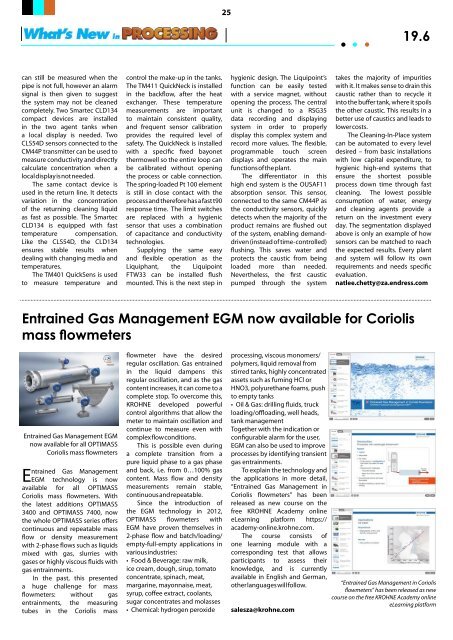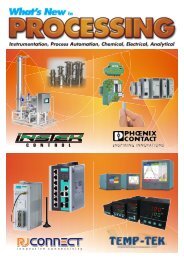WNIP NOV DEC 19.6 DIGITAL
You also want an ePaper? Increase the reach of your titles
YUMPU automatically turns print PDFs into web optimized ePapers that Google loves.
25<br />
<strong>19.6</strong><br />
can still be measured when the<br />
pipe is not full, however an alarm<br />
signal is then given to suggest<br />
the system may not be cleaned<br />
completely. Two Smartec CLD134<br />
compact devices are installed<br />
in the two agent tanks when<br />
a local display is needed. Two<br />
CLS54D sensors connected to the<br />
CM44P transmitter can be used to<br />
measure conductivity and directly<br />
calculate concentration when a<br />
local display is not needed.<br />
The same contact device is<br />
used in the return line. It detects<br />
variation in the concentration<br />
of the returning cleaning liquid<br />
as fast as possible. The Smartec<br />
CLD134 is equipped with fast<br />
temperature compensation.<br />
Like the CLS54D, the CLD134<br />
ensures stable results when<br />
dealing with changing media and<br />
temperatures.<br />
The TM401 QuickSens is used<br />
to measure temperature and<br />
control the make-up in the tanks.<br />
The TM411 QuickNeck is installed<br />
in the backflow, after the heat<br />
exchanger. These temperature<br />
measurements are important<br />
to maintain consistent quality,<br />
and frequent sensor calibration<br />
provides the required level of<br />
safety. The QuickNeck is installed<br />
with a specific fixed bayonet<br />
thermowell so the entire loop can<br />
be calibrated without opening<br />
the process or cable connection.<br />
The spring-loaded Pt 100 element<br />
is still in close contact with the<br />
process and therefore has a fast t90<br />
response time. The limit switches<br />
are replaced with a hygienic<br />
sensor that uses a combination<br />
of capacitance and conductivity<br />
technologies.<br />
Supplying the same easy<br />
and flexible operation as the<br />
Liquiphant, the Liquipoint<br />
FTW33 can be installed flush<br />
mounted. This is the next step in<br />
hygienic design. The Liquipoint’s<br />
function can be easily tested<br />
with a service magnet, without<br />
opening the process. The central<br />
unit is changed to a RSG35<br />
data recording and displaying<br />
system in order to properly<br />
display this complex system and<br />
record more values. The flexible,<br />
programmable touch screen<br />
displays and operates the main<br />
functions of the plant.<br />
The differentiator in this<br />
high end system is the OUSAF11<br />
absorption sensor. This sensor,<br />
connected to the same CM44P as<br />
the conductivity sensors, quickly<br />
detects when the majority of the<br />
product remains are flushed out<br />
of the system, enabling demanddriven<br />
(instead of time-controlled)<br />
flushing. This saves water and<br />
protects the caustic from being<br />
loaded more than needed.<br />
Nevertheless, the first caustic<br />
pumped through the system<br />
takes the majority of impurities<br />
with it. It makes sense to drain this<br />
caustic rather than to recycle it<br />
into the buffer tank, where it spoils<br />
the other caustic. This results in a<br />
better use of caustics and leads to<br />
lower costs.<br />
The Cleaning-In-Place system<br />
can be automated to every level<br />
desired – from basic installations<br />
with low capital expenditure, to<br />
hygienic high-end systems that<br />
ensure the shortest possible<br />
process down time through fast<br />
cleaning. The lowest possible<br />
consumption of water, energy<br />
and cleaning agents provide a<br />
return on the investment every<br />
day. The segmentation displayed<br />
above is only an example of how<br />
sensors can be matched to reach<br />
the expected results. Every plant<br />
and system will follow its own<br />
requirements and needs specific<br />
evaluation.<br />
natlee.chetty@za.endress.com<br />
Entrained Gas Management EGM now available for Coriolis<br />
mass flowmeters<br />
Entrained Gas Management EGM<br />
now available for all OPTIMASS<br />
Coriolis mass flowmeters<br />
Entrained Gas Management<br />
EGM technology is now<br />
available for all OPTIMASS<br />
Coriolis mass flowmeters. With<br />
the latest additions OPTIMASS<br />
3400 and OPTIMASS 7400, now<br />
the whole OPTIMASS series offers<br />
continuous and repeatable mass<br />
flow or density measurement<br />
with 2-phase flows such as liquids<br />
mixed with gas, slurries with<br />
gases or highly viscous fluids with<br />
gas entrainments.<br />
In the past, this presented<br />
a huge challenge for mass<br />
flowmeters: without gas<br />
entrainments, the measuring<br />
tubes in the Coriolis mass<br />
flowmeter have the desired<br />
regular oscillation. Gas entrained<br />
in the liquid dampens this<br />
regular oscillation, and as the gas<br />
content increases, it can come to a<br />
complete stop. To overcome this,<br />
KROHNE developed powerful<br />
control algorithms that allow the<br />
meter to maintain oscillation and<br />
continue to measure even with<br />
complex flow conditions.<br />
This is possible even during<br />
a complete transition from a<br />
pure liquid phase to a gas phase<br />
and back, i.e. from 0…100% gas<br />
content. Mass flow and density<br />
measurements remain stable,<br />
continuous and repeatable.<br />
Since the introduction of<br />
the EGM technology in 2012,<br />
OPTIMASS flowmeters with<br />
EGM have proven themselves in<br />
2-phase flow and batch/loading/<br />
empty-full-empty applications in<br />
various industries:<br />
• Food & Beverage: raw milk,<br />
ice cream, dough, sirup, tomato<br />
concentrate, spinach, meat,<br />
margarine, mayonnaise, meat,<br />
syrup, coffee extract, coolants,<br />
sugar concentrates and molasses<br />
• Chemical: hydrogen peroxide<br />
processing, viscous monomers/<br />
polymers, liquid removal from<br />
stirred tanks, highly concentrated<br />
assets such as fuming HCl or<br />
HNO3, polyurethane foams, push<br />
to empty tanks<br />
• Oil & Gas: drilling fluids, truck<br />
loading/offloading, well heads,<br />
tank management<br />
Together with the indication or<br />
configurable alarm for the user,<br />
EGM can also be used to improve<br />
processes by identifying transient<br />
gas entrainments.<br />
To explain the technology and<br />
the applications in more detail,<br />
“Entrained Gas Management in<br />
Coriolis flowmeters” has been<br />
released as new course on the<br />
free KROHNE Academy online<br />
eLearning platform https://<br />
academy-online.krohne.com.<br />
The course consists of<br />
one learning module with a<br />
corresponding test that allows<br />
participants to assess their<br />
knowledge, and is currently<br />
available in English and German,<br />
other languages will follow.<br />
salesza@krohne.com<br />
“Entrained Gas Management in Coriolis<br />
flowmeters” has been released as new<br />
course on the free KROHNE Academy online<br />
eLearning platform











